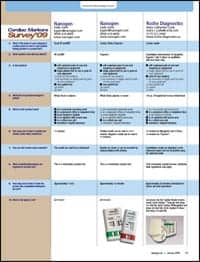Just in time for a new flu season, in which up to 20% of Americans may be affected, 3M announces nationwide availability of the 3M™ Rapid Detection Flu A+B Test.
The Rapid Detection Flu A+B Test is the first rapid flu test to provide automated results. The automated technology helps reduce user interpretation errors, which can lead to both false negative or false positive results. The 3M Rapid Detection Flu A+B Test will be able to deliver hospital and physician office laboratories reliable and objective electronic results in 15 minutes.
“Bringing automation to the interpretation of influenza tests is a key factor for the next generation of rapid flu tests,” said Brian Anderson, marketing manager, 3M Health Care. “Automating and storing the objective result of a flu test will help increase laboratory productivity and minimize the potential for human error, which can contribute to improving patient outcomes.”
Requiring less than three minutes of prep time, the Rapid Detection Flu A+B Test detects positive or negative results, and differentiates influenza A and influenza B with results clearly displayed on the rapid detection reader. In addition to providing automated results, the technology also enables labs to export data through laboratory information systems, further reducing the potential for reporting error by eliminating the need for manual recording and transferring of patient results. The test also reads and stores lab results, giving lab technicians more flexibility in time and test management.
“Properly interpreting test results is critical, especially considering that most flu antiviral medications have a 48-hour recommended therapeutic window for prescribing, so false-positives or even delayed test results may result in misapplication of therapy or may reduce its effectiveness,” said Christine Ginocchio, PhD, Director of Microbiology, Virology and Molecular Diagnostics at North Shore Long Island Jewish Health System. “Having an automated reader almost eliminates the potential for misinterpreting results, leading to a faster and more informed treatment decision, which results in better patient outcomes.”
A recent study evaluated the Rapid Detection Flu A+B Test against the leading hospital brand and two conventional methods of diagnosing influenza A and B, direct fluorescent antibody staining (DFA) (1.5 to 3 hours for results) and rapid cell culture (R-Mix) (24 to 48 hours for results). Compared to the leading hospital brand, the Rapid Detection Flu Test demonstrated superior analytical and clinical sensitivity for the detection of both influenza A and B. Further, the study concluded that the automated reading of test results eliminated the potential for user misreading or misinterpretation of test results.


